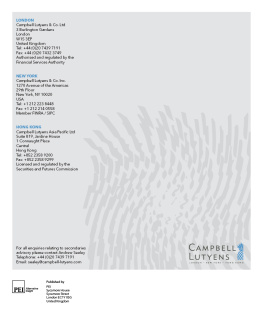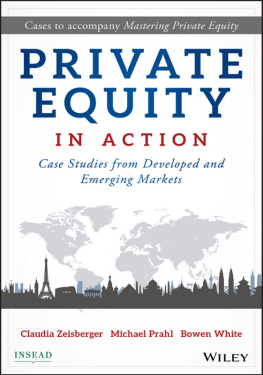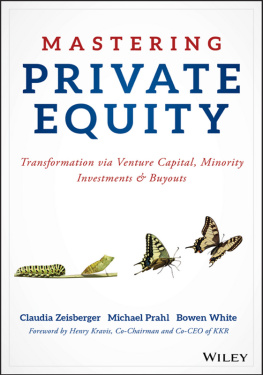Published in March 2013 by
PEI
Second Floor
Sycamore House
Sycamore Street
London EC1Y 0SG
United Kingdom Telephone: +44 (0)20 7566 5444
www.peimedia.com 2013 PEI ISBN 978-1-908-783-07-3 eISBN 978-1-908-783-57-8 |  |
This publication is not included in the CLA Licence so you must not copy any portion of it without the permission of the publisher.
All rights reserved. No parts of this publication may be reproduced, stored in a retrieval system or transmitted in any form or by any means including electronic, mechanical, photocopy, recording or otherwise, without written permission of the publisher.
Disclaimer: This publication contains general information only and the contributors are not, by means of this publication, rendering accounting, business, financial, investment, legal, tax, or other professional advice or services. This publication is not a substitute for such professional advice or services, nor should it be used as a basis for any decision or action that may affect your business. Before making any decision or taking any action that may affect your business, you should consult a qualified professional adviser. Neither the contributors, their firms, its affiliates, nor related entities shall be responsible for any loss sustained by any person who relies on this publication.
The views and opinions expressed in the book are solely those of the authors and need not reflect those of their employing institutions.
Although every reasonable effort has been made to ensure the accuracy of this publication, the publisher accepts no responsibility for any errors or omissions within this publication or for any expense or other loss alleged to have arisen in any way in connection with a readers use of this publication.
PEI editors: Anthony OConnor and Helen Lewer
Production editor: Julie Foster
Printed in the UK by: Ashford Colour Press (ashford-colour-press.co.uk)
Contents
What makes emerging markets attractive?
12Valuation dynamics in private equity secondaries
Figures and tables
Figures
Figure 7.3:Secondaries market sellers (by value), 2011 and 2012
Tables
About Campbell Lutyens
Campbell Lutyens is a specialist adviser in the private equity and infrastructure sectors and is focused on global fund placement and secondary transactions. Founded in 1988 and independent, the firm has longstanding experience and relationships which enable it to bring best quality advice and delivery for its clients.
The firm has offices in London, New York and Hong Kong and comprises of a team of over 65 international executives, advisors and staff with global and broad-ranging expertise in the private equity sector.
Campbell Lutyens provides specialist advice to institutions, general partners and other organisations on all aspects of the private equity sector, including the sale and restructuring of portfolios both of limited partnership fund interests and of direct portfolios of private equity and infrastructure investments. Advisory transaction mandates typically range in size from $50 million to $3 billion. The firms track record includes advising on over $30 billion in value across more than 65 private equity secondary transactions.
Campbell Lutyens also assists private equity and infrastructure managers in raising funds and advises on all stages and aspects of the fundraising process including strategy, documentation and structuring. The firm acts for European, Asian and Global managers raising private equity and infrastructure funds typically of between $200 million and $2 billion in size from institutional investors globally. In the private equity sector it has raised venture capital, development capital, buyout, distressed debt, special situation and mezzanine funds. In the infrastructure sector it has raised both greenfield and brownfield funds and helped develop appropriate fund structures to address the specific requirements of institutional investors. 
1
Introduction
By Andrew Sealey, Campbell Lutyens
The financial landscape has changed significantly in the five years since 2008 and the private capital markets have also been materially impacted. In 2008, when the first edition of The Private Equity Secondaries Market was published, it was difficult to predict the impact the impending credit crisis and subsequent global financial crisis would have on both the primary and secondary markets. While the primary fundraising markets have suffered over the last five years, the secondary market for private equity and related asset classes (including infrastructure and real estate) has continued to grow and mature. The secondary market, particularly in private equity, is now firmly established as a substantial and sophisticated part of the market, which is integral to the wider industry.
Since 2007, private equity secondary market volumes have grown by approximately 95 percent reaching a record level of approximately $26 billion in 2012. This period of growth has seen fairly consistent annual increases; the exception was 2009 when rapidly falling asset values and market uncertainty led to a considerable valuation gap between buyers and sellers and a corresponding material drop in completed transactions. Despite this, the period 2008 to 2012 saw an estimated $92 billion of secondary transactions completed versus $46 billion in the previous five years (2003 to 2007), representing an increase of almost 100 percent.
This market growth has occurred against a backdrop of what is widely considered to have been the worst global economic crisis since the 1930s and has, in part, been fuelled by sellers impacted by the financial crisis together with new regulatory developments. However, the underlying historic growth of the private equity asset base has arguably been a more important contributor to growth. The growth in market volume (with the notable exception of 2009) has remained at a fairly consistent percentage of the global assets committed to the asset class.
The increase in demand for early liquidity from investors has been matched by increasing demand from both traditional secondary buyers as well as new, historically more primary-focused investors. Specialist secondary funds raised over $100 billion between 2008 and 2012; a time when institutions have generally been very cautious about commitments to the private equity market and when overall fundraising has dropped by around 50 percent from the peak years of 2007 and 2008.
Recent developments
A material proportion of secondary sales have been from banks, driven by the regulatory pressure of Basel II and III, the need to improve Tier I capital requirements, the desire to improve balance sheet utilisation, in some cases pressure to shrink balance sheets and in others to exit non-core activities. In 2011 and 2012, bank sales represented almost 35 percent of the secondary market by volume. Further legislation, including ringfencing and the finalisation of the Dodd Frank/Volcker legislation, could contribute to further sales of private equity assets from US banks and probably from most other larger banks around the world.

















